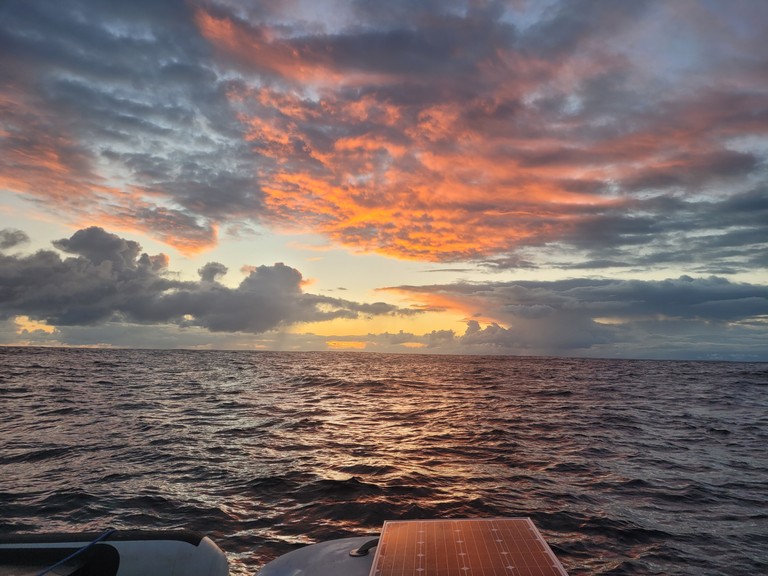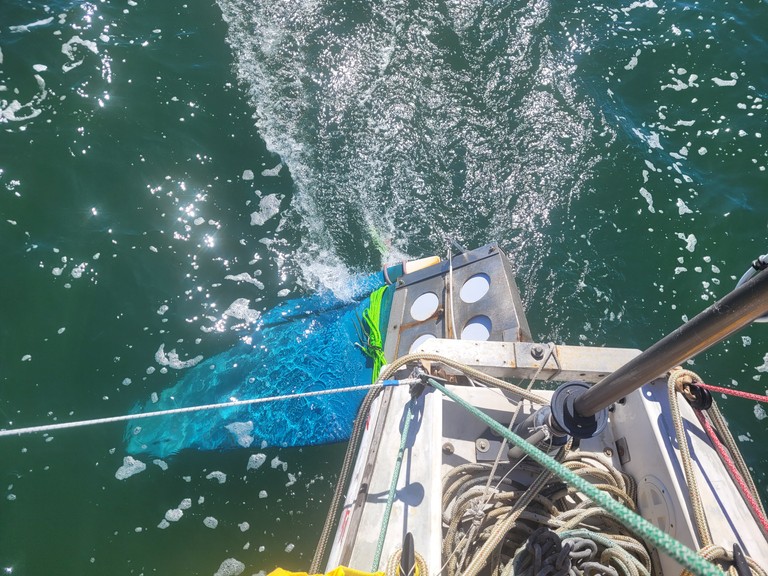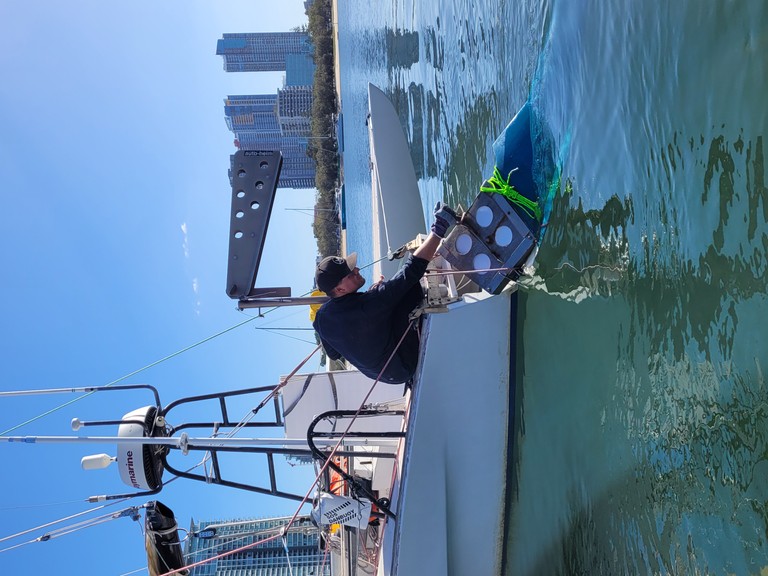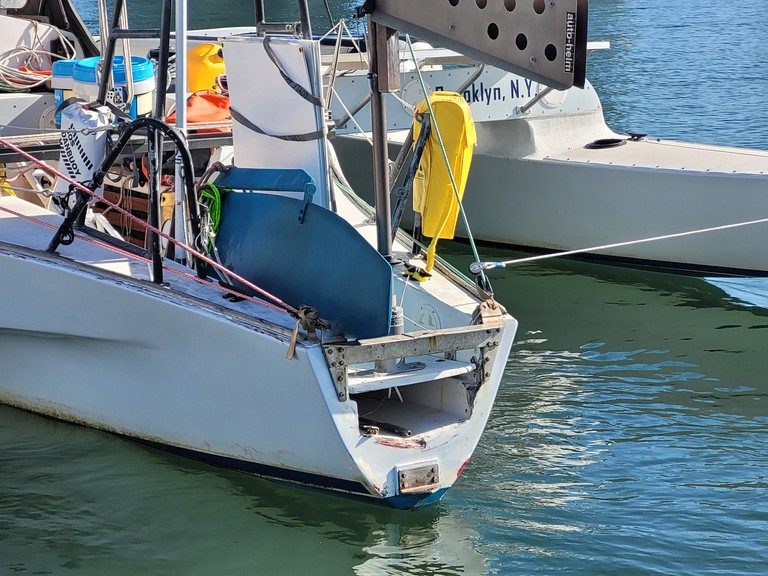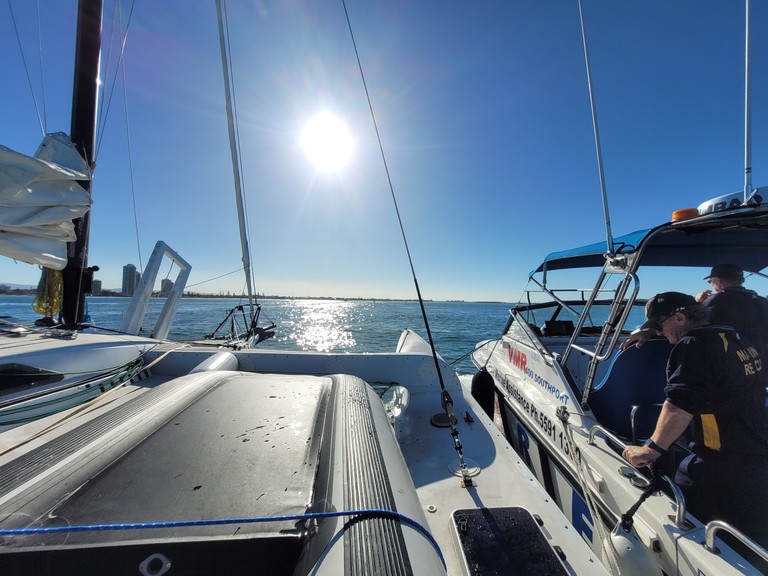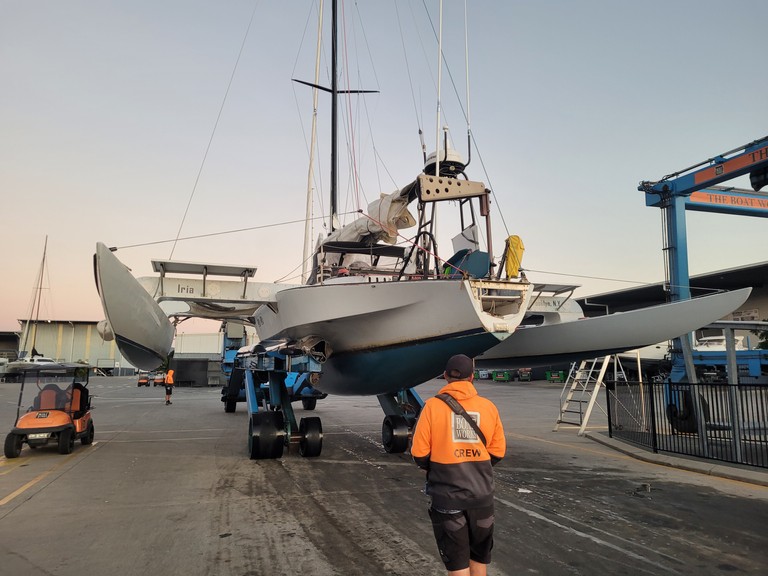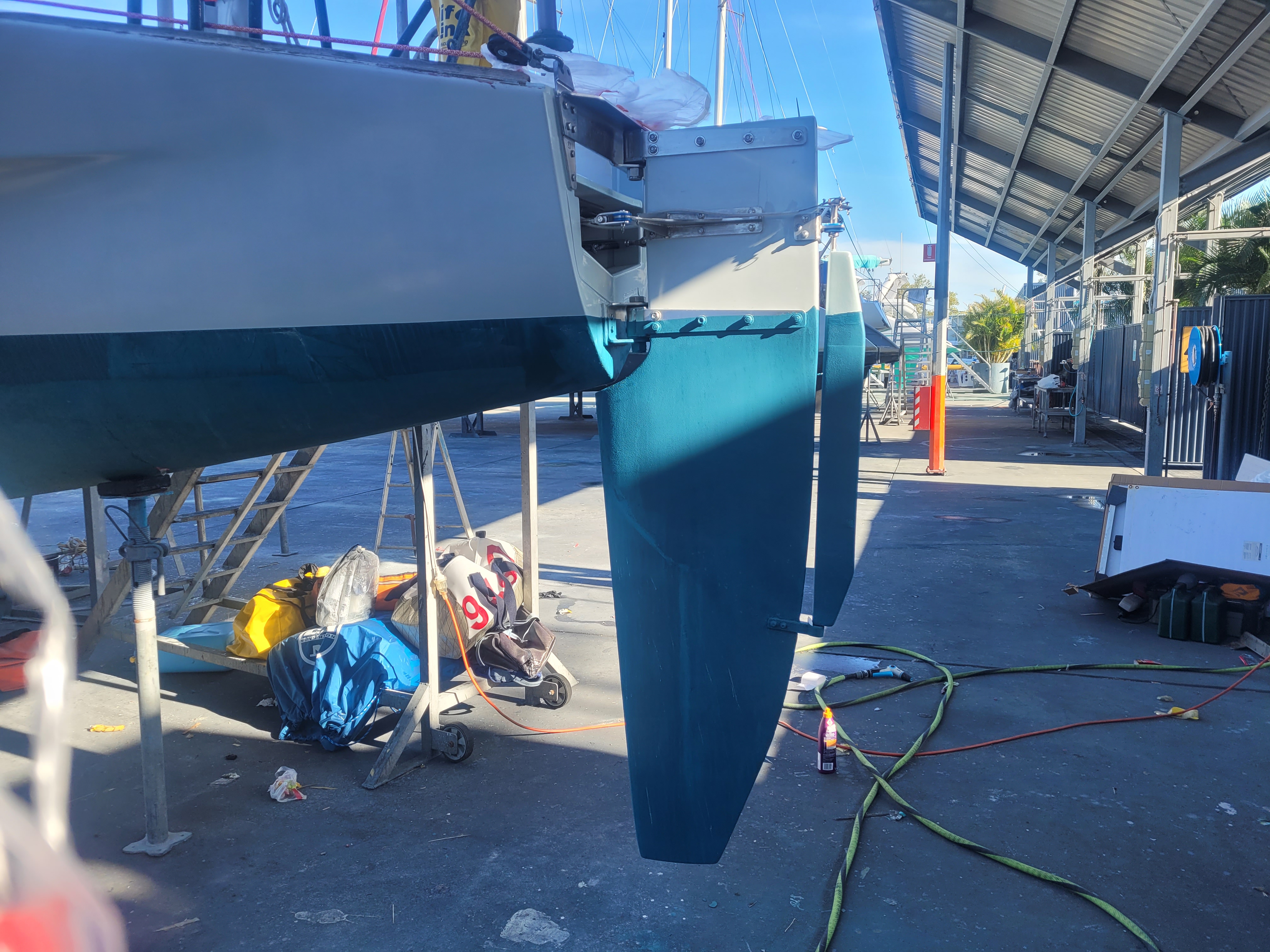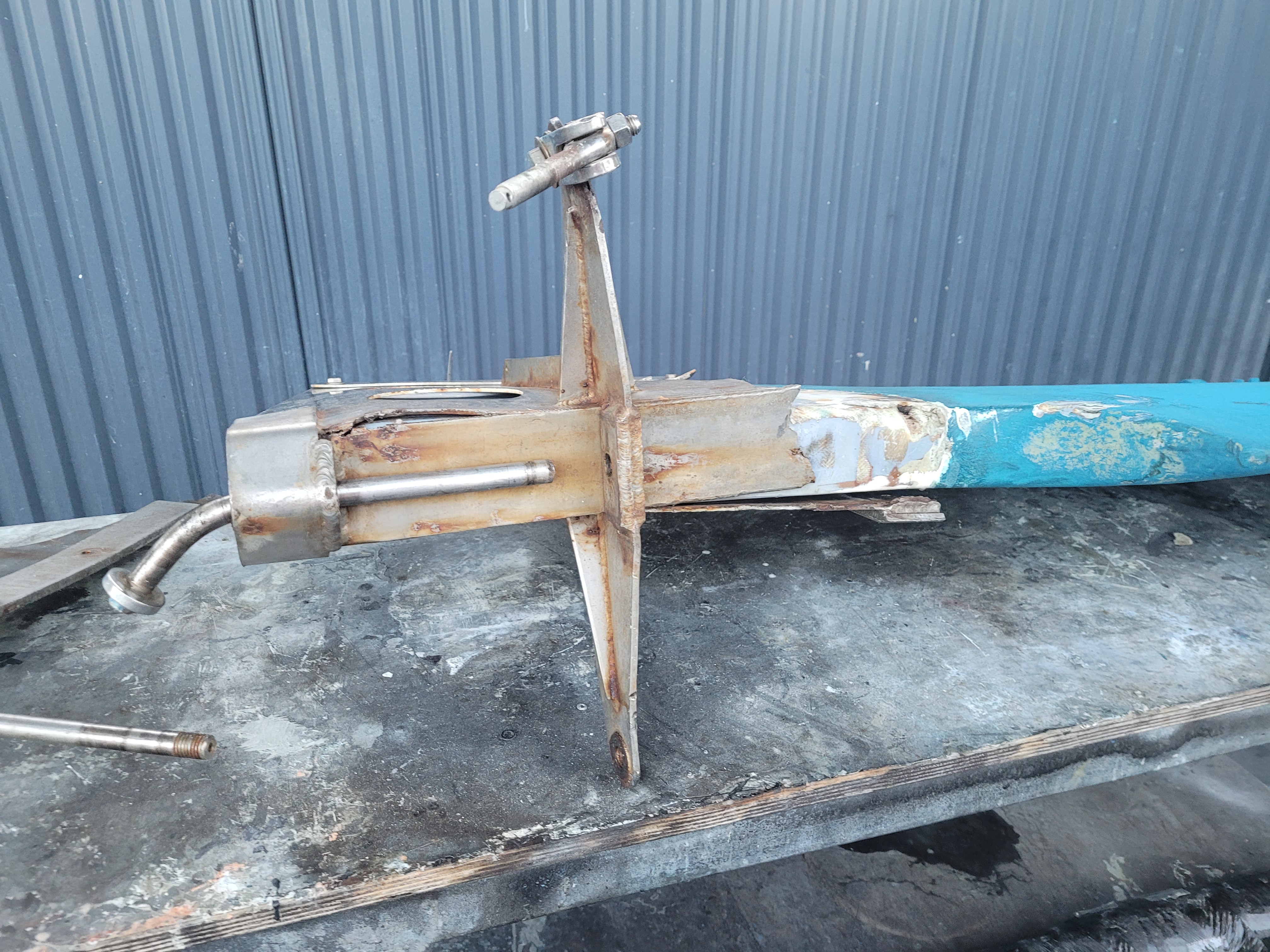Shit Happens (part 1)
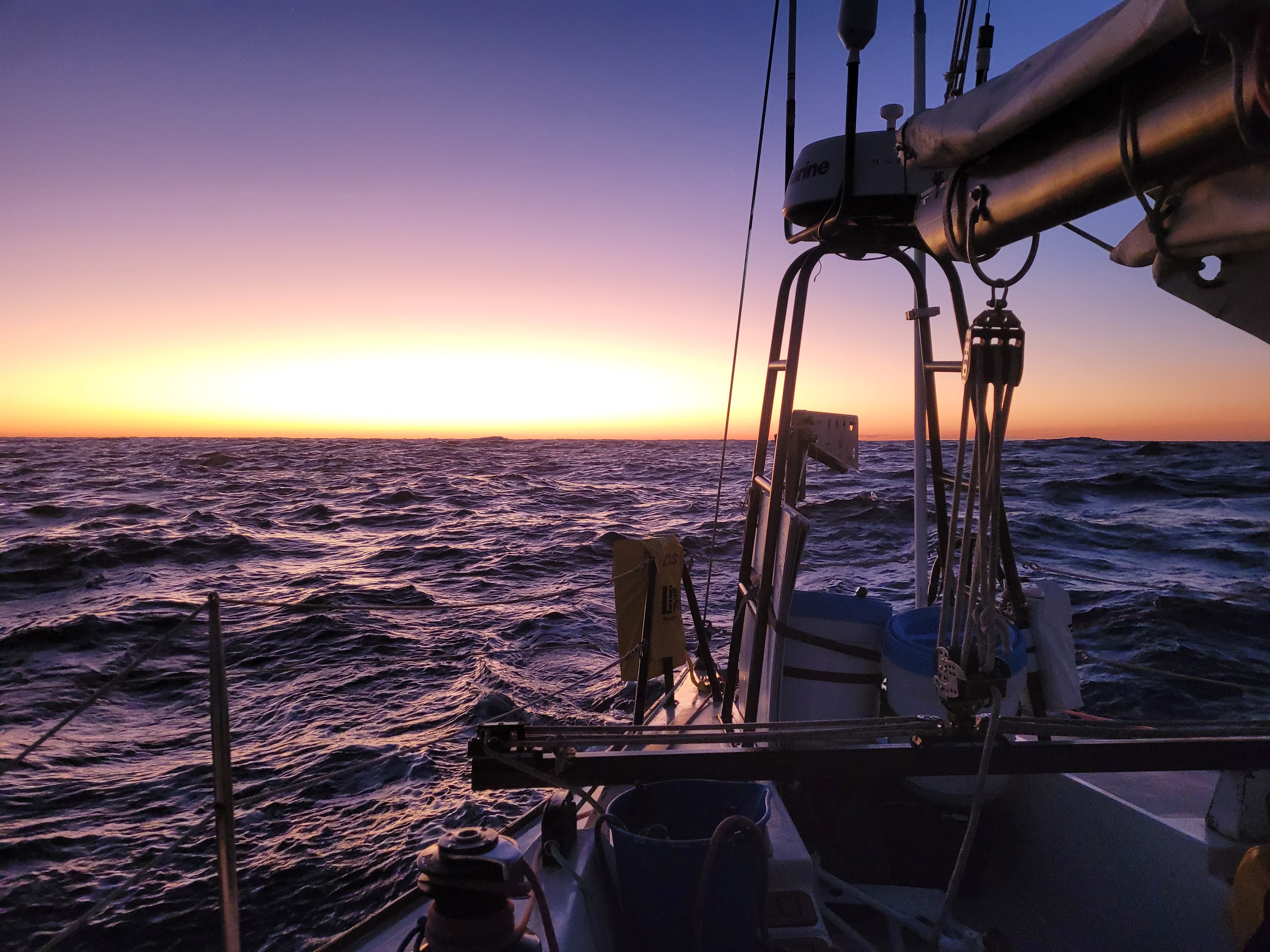
The lead up to rally departure was a bit of a whirlwind. We finished all the essential tasks, got our food provisioning done around 10pm before departure day, and sorted the boat as well as we could while still grabbing a few hours of sleep. Frankly, not my favorite way to depart on a big trip, but necessary under the circumstances. We had a weather window to catch, and catch it we did.
Departure was mostly smooth. We got cleared out of Australia, hoisted the sail with one reef in, fouled the lazy running backstay* on the way out, and hit the Southport Seaway bar crossing with vigor.
And with all our anchor bridle kit still out on the foredeck, forgotten in the rush. Thankfully, the forward nets caught it all and I was able to stow it once we crossed the big rolling swell coming across the bar. No breakers, but it was a bit gnarly. Once through the bar, I went forward and retrieved our nearly-overboard anchoring gear before it dove off the nets.
Gnarly was the watchword for the next 24 hours or so, if not more. The swell as forecast as a 3-4 meter southerly swell, with a long 11 second period. Big, and right on the beam, but long enough in period that we would ride comfortably over it. That wasn't the trouble. The trouble - at first anyway - was the wind waves kicked up, combined with a cross-current further out. The combined sea state would be best described as "lumpy," and maybe more illustratively described as "a washing machine." As the day developed, we went from comfortably bashing along at 8-10 knots, to having to slow down as much as we could as the wind increased and the washing machine continued its rinse cycle.

Despite the pounding through this confused sea, we had some beautiful moments. For about an hour, a pod of 20-30 dolphins played off Iria's three bows, jumping and diving all around us. Later, massive schools of flying fished leapt out of the water, gliding gracefully away from our oncoming bow wake. It was a beautiful day - not comfortable, but just gorgeous being out there.
As night fell, slowing the boat down proved difficult. We took in a second reef, and eventually I furled the jib almost completely away. That helped, but we would still hit 10 knots in the gusts, surfing sometimes up to 12+ knots as one wave lifted us up until bashing into some other set coming from a totally different direction. I was on deck solo by this point, crew disabled from seasickness.
I made it through most of the night that way okay, sleeping in 20 minute bursts between checking for traffic nearby and tending to the sails and adjusting the autopilot as the wind and wave trains shifted. Crew stood at least one watch, though in our sleep-deprived state neither of us can remember exactly when. My best guess is it was in the early morning sometime, and I got a bit of rest before what happened next.
Back on watch just before daybreak, around 5:30am and about 160 miles offshore, I noticed the electric autopilot - which had been dutifully steering us all night - was struggling to keep its course. Assuming the usual failure modes for that kind of autopilot, I figured maybe it just couldn't keep up with the confused seas and hefty wind, and tried hand-steering for a bit instead. That was when the problem became more obvious - even with both hands on the tiller, straining hard, I could hardly move the tiller an inch or two in either direction. The boat isn't lacking for rudder, and has been out in worse wind and still been easy to steer with just a few fingers on the tiller. I knew something had gone badly wrong.
Once it was bright enough to see, around 6am, I called crew on deck to let them know I needed to go back and check the rudder. It was worse than I feared. For context, the rudder on Iria is a stern-hung design, like a giant version of a dinghy rudder. It's connected at multiple points to metal posts on the transom, and has its own big metal cage holding the rudder, all connected with a hefty metal pin.
The cage itself had split near the bottom, leaving the rudder tilting off to one side with no connection to the boat. On top of that, the metal pin was bent at a nearly 60 degree angle right in the middle. No wonder it was impossible to move the tiller! The rudder was jammed and broken, and the bent pin made it unable to turn and impossible to remove.
We dropped the mainsail, furled away the last bit of the jib, and I called a Pan Pan** on the radio to let nearby vessels know we were disabled. Through the night, about 4 other boats in the rally had remained within about 2 miles - kind of astonishing, given we were all different kinds of boats with very different sailing characteristics. One - a 45-foot monohull named Lai Lai Lady - had been within about 1/4 mile for the last few hours. They and a couple other boats responded almost immediately, to say they would stand by while we inspected the damage and considered whether we could effect a jury-rigged steering fix.
I took a closer look at the rudder damage, considered what we had to jury-rig it with, and came to a frustrating conclusion. If we could've removed the rudder, or even removed that pin, we probably could jury rig something. I carry a full set of rudder repair kit aboard, as well as material to make a new rudder and tiller, so was hopeful it would be possible. But the bent pin made attaching new rudder gear impossible. On top of that, the sea conditions made trying to work anywhere near those damaged metal parts extremely hazardous.
Calling back on the radio, I informed our rallymates that we wouldn't be able to effect a jury-rig repair. Lai Lai Lady was the nearest, and first to respond - they offered almost immediately to attempt to tow us back to Australia. That's a long trip under tow, and neither of us had towed vessels of this size before, though we understood the techniques involved well.
The biggest dangers in a tow like that come from the forces on the towing line itself - two large vessels, moving differently in different parts of the waves, can exert massive forces on that line. It needs to be strong so it doesn't break, but elastic so it can act as an effective shock absorber. We discussed via radio how to accomplish this safely, and quickly found our solution: I carry two drogues aboard, and a ~400ft drogue line made of strong, elastic double-braid line. On our end, I made a bridle from two drogue bridle attachments at the bow, my anchor bridle, a heavy-duty swivel (also from the drogue kit, used to keep the line from twisting itself apart), all made off to one end of the massive drogue line. We attached that to a fender on the other end of the drogue line, so Lai Lai Lady could pick it up from a safe distance. They did so, and made their end off to a bridle made from an 18mm dock line and attached to their aft cleats.
Amazingly, they caught the fender on the first try, got it hooked up, and we were soon under tow. We tested it at very low speed first, then slowly increased our speed to about 4 knots as the towing line seemed secure on all points. It would be a long trip back, but we were safely under way again!
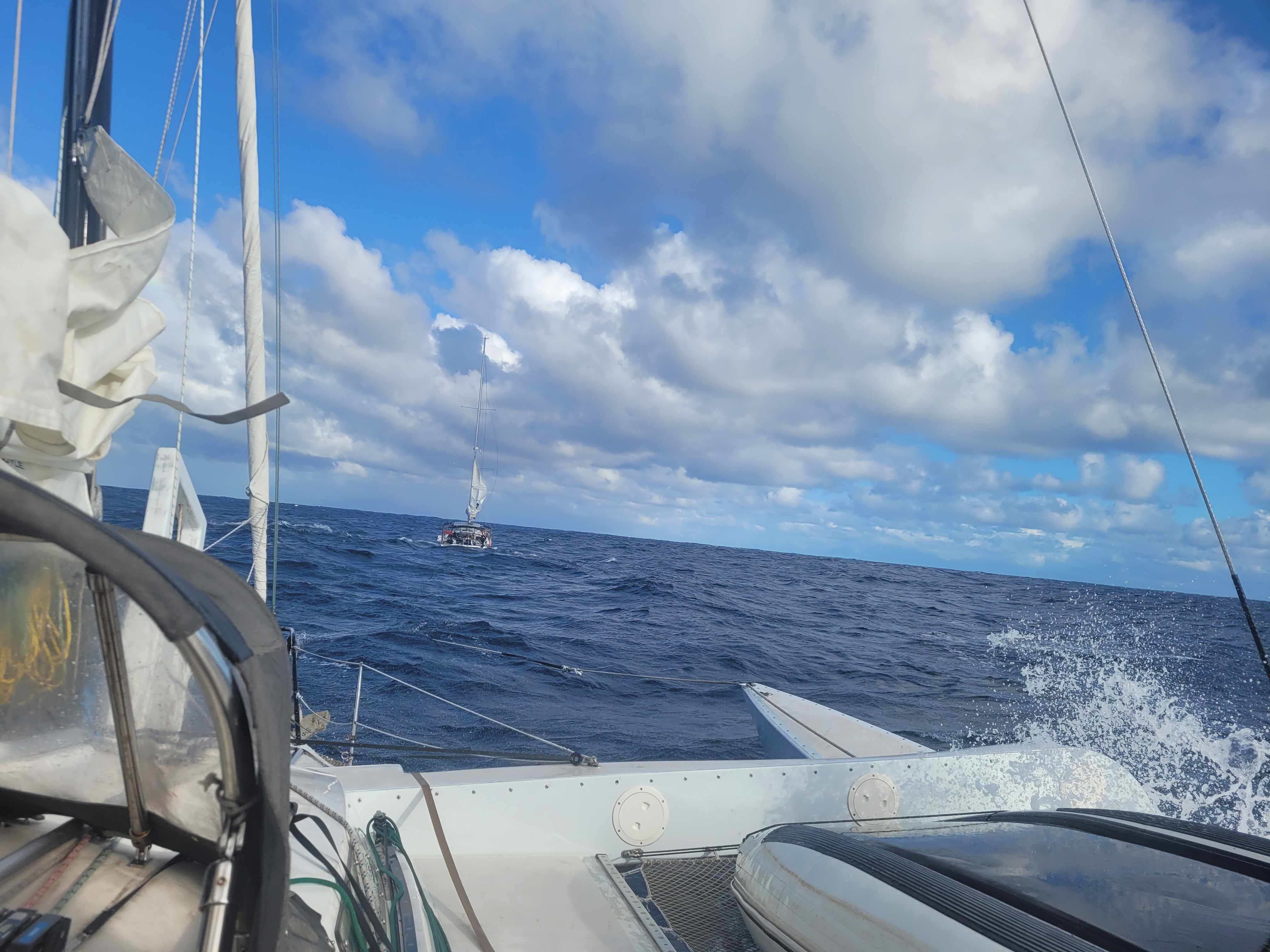
Before we committed to this plan, I called AMSA's emergency coordination center via satellite phone (AMSA being the Australian Maritime Safety Authority - among other things, the coordination center for marine rescue). They advised they couldn't tow us from that distance, but could send out a rescue helicopter if we could not effect a better solution and needed to be removed from the boat. As all crew were safe, and the boat was not in imminent danger, we decided to attempt the tow first, and set up a call-in schedule with AMSA every two hours. It was a huge comfort to have them aware of our situation and position.
Our tow continued slowly but safely over the still-confused seas of this second morning. All hands watched the tow line closely for these first many hours, looking for signs of chafe or breakage. It held - it was also long enough (or, luckily, just the right length) to keep the two boats in similar parts of their respective sea-state. That's important, as it keeps the shock-loads on the tow line to a minimum. I'm not sure if that was good design of our tow line, or just sheer luck. Maybe it was some combination of both.
Once confident the tow was secure, I went below to get some much needed sleep.
All went slowly but surely, with occasional calls in to AMSA and to the rally organizer to make sure they knew our situation.
Then, a bit after midnight (why do these things always happen between midnight and 5am? Does Murphy awake to enforce his laws only in the wee hours?), Lai Lai Lady's autopilot malfunctioned and their vessel made a sharp 120 degree turn. I was off-watch at the time, so I rely on my crew's report and our debrief later with Lai Lai Lady's crew for what happened next. It sounds as if they tried to reduce revs and avoid us, but still wrapped their bridle line (or maybe the near-end of our towing line) around their propeller. We mostly avoided contact (our starboard hull made light contact with what we later realized was their liferaft container, cracking the fiberglass shell of the container but causing no other damage), but we were now two disabled vessels drifting much too close together.
I started our engine. Even without steerage, a bit of reverse should allow our much lighter vessel to keep its distance without putting too much strain on the line (or, more importantly, on their propeller gear which now held the line fast). We discussed via radio, and all agreed it was best to hold position, keep distance, and wait until morning to try and sort out the problem. This was an excellent decision, and we stayed safely apart through morning. Once dawn broke and there was enough light to see, one of Lai Lai Lady's crew dove overboard with a diving "hookah" on - basically, a kit to allow them to breath underwater from an on-deck source of air. They quickly managed to unwrap the prop, got back aboard, and we were again underway. It was an amazing bit of seamanship from their crew, and we were all lucky the prop was only slightly wrapped by the line. Another stroke of luck in our tandem voyage back.

The rest of the day was taken up by further careful watch of the towing line, some joy as the sea state calmed down to a much more reasonable state, and a brief pause while I attempted a jury-rig repair in the newly calmed down conditions. It held enough to stop the broken rudder sawing its way through the stern of the boat, but wasn't solid enough to allow us to steer. In the calm seas and with the rudder in a better position at least for now, we were able to increase speed slightly. By now, we were close enough for AMSA to determine a rough ETA, and we kept monitoring it through the day.
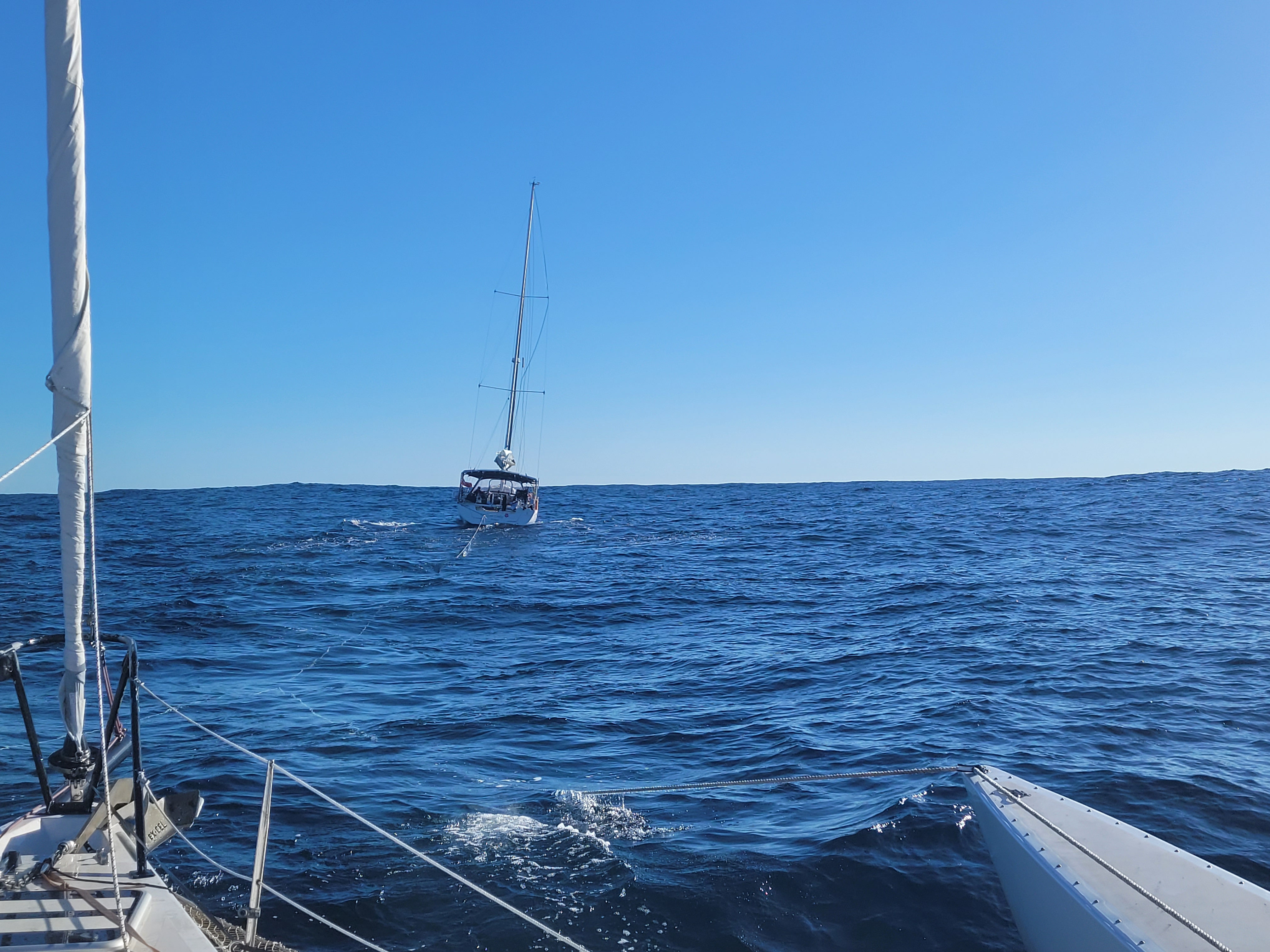
That night, however, we were getting close enough to the coast that a new danger appeared - commercial traffic. Giant ships bounding across the sea at great speed, with little ability to turn or stop on short notice. Both our vessels kept a careful watch on AIS***, radar, and any navigation lights looming up off the horizon. One ship arrived on a course too close for comfort, but I was able to call them via radio and they altered course enough to keep our distance safe.
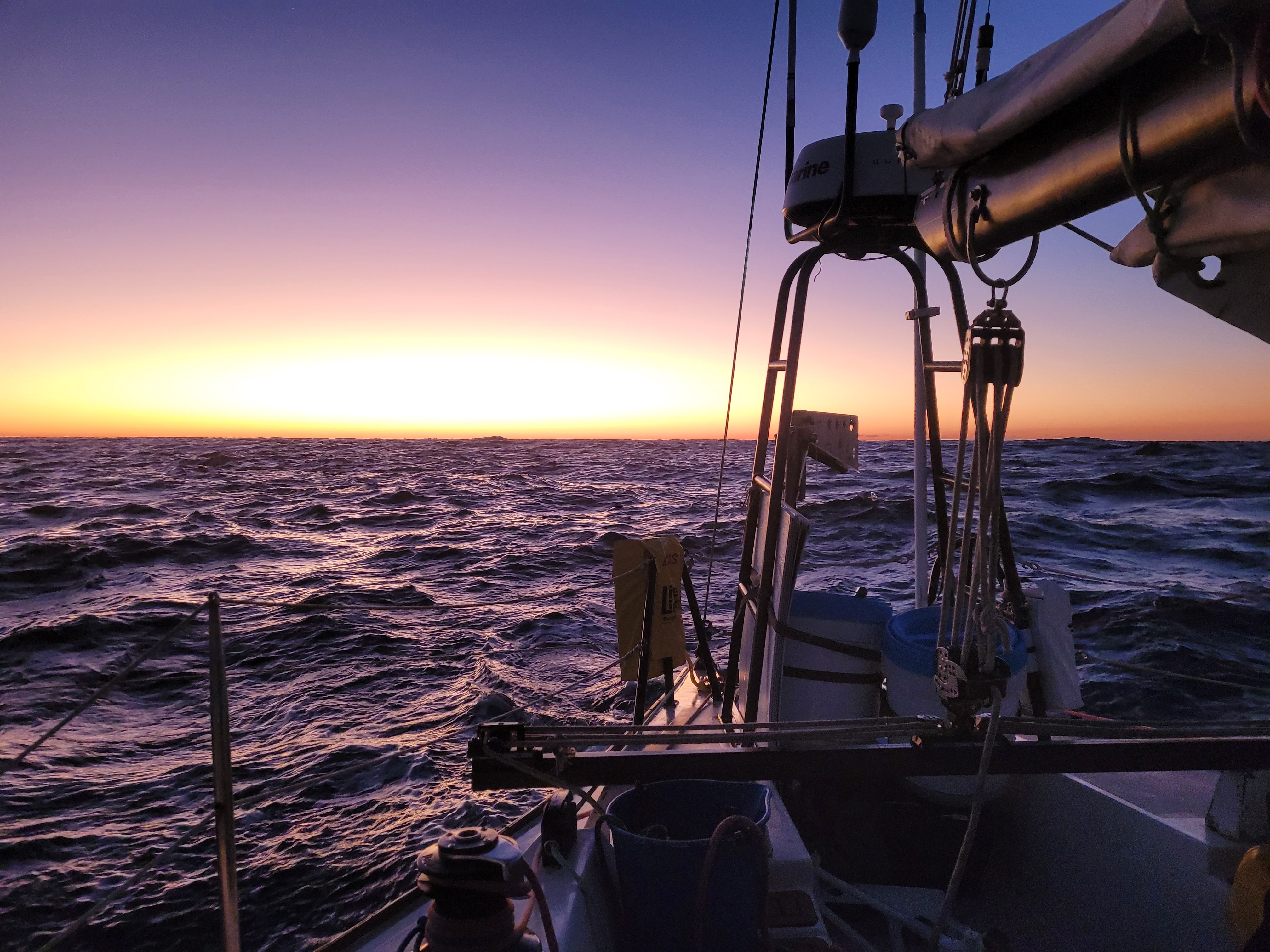
By morning, we were only about 30 miles off the coast. I called AMSA again to confirm our status and provide a new ETA, and arranged with a coastal rescue organization (Volunteer Marine Rescue - an amazing institution here in Australia, fully volunteer and donation-based but providing critical rescue services for stricken vessels along Australia's coast). Because the return trip required passing over the same tricky bar crossing, we arranged to transfer the tow to them about 15 miles offshore.
We got lucky again. The tow was successfully transferred, we were in VMR's capable hands, and - luck of all luck - the bar crossing was calm that day. VMR brought us in, with two boats ahead of our tow vessel to make sure the traffic was clear as we came in.
About 40 minutes later, we were tied up safely in the exact same berth we had cleared out from just 4 days ago. Lai Lai Lady was docked up next to us, and - once allowed off the boat by Australian Border Force - we exchanged hugs and all took a collective relaxing breath.
A day or so later, once all had gotten some much needed rest and recovery time, we took their crew out to a luxurious celebration dinner. It was great to spend some time in person, having spent so long coordinating over radio in close quarters. It was also helpful to swap experiences and stories of our time under tow.
We're back ashore now, relaxing and recovering for a few days before digging in to the numerous boat projects. The rudder itself is largely intact, but the metal cage that holds it is destroyed and repairing that is well beyond my skillset. I'm not sure exactly when the vessel will be seaworthy again, but that's tomorrow's problem. The boat is now back at Boat Works and pulled up onto the hardstands for repair, and I'm hoping to write a Part 2 to this once I can examine the damage more closely and look at the root causes of what failed and how.
My sincerest thanks to the crew of Lai Lai Lady, without whom we may not have made it back to safety. I'm also extraordinarily grateful for my crew, as they handled this perilous situation with extraordinary grace and confidence. Thanks also to the Down Under Rally organizers, AMSA, Volunteer Marine Rescue, and Southport Yacht Club, for all their help in our safe return.
-------
* The running backstays help stabilize the mast by providing an aft-pulling support. The fouled one was, thankfully, the lazy - more sailing jargon meaning "the one we're not using" - one for our entire forecasted route. Not ideal, but not a problem for sailing in these conditions.
** In the hierarchy of emergency radio calls, a Pan Pan is sort of the middle ground. It's less severe than a Mayday - indicating imminent danger to vessel or crew - but more severe than a Securite call - usually used to announce a general notice such as floating debris nearby or minor vessel issues. Pan Pan is sort of a "be aware" call, to warn of trouble or a potentially escalating situation such as the one we had.
*** "AIS" or Automatic Identification System is a radio-based protocol for identifying vessels. Commercial ships are required to use it, and many recreational vessels use it as well. It sends a signal that AIS receivers can turn into information about vessel size, location, heading, and speed - which can then be displayed on a chartplotter or display device, which can in turn send an automatic warning if any vessel's AIS indicates a course and speed that pose a risk of collision or uncomfortably close approach.
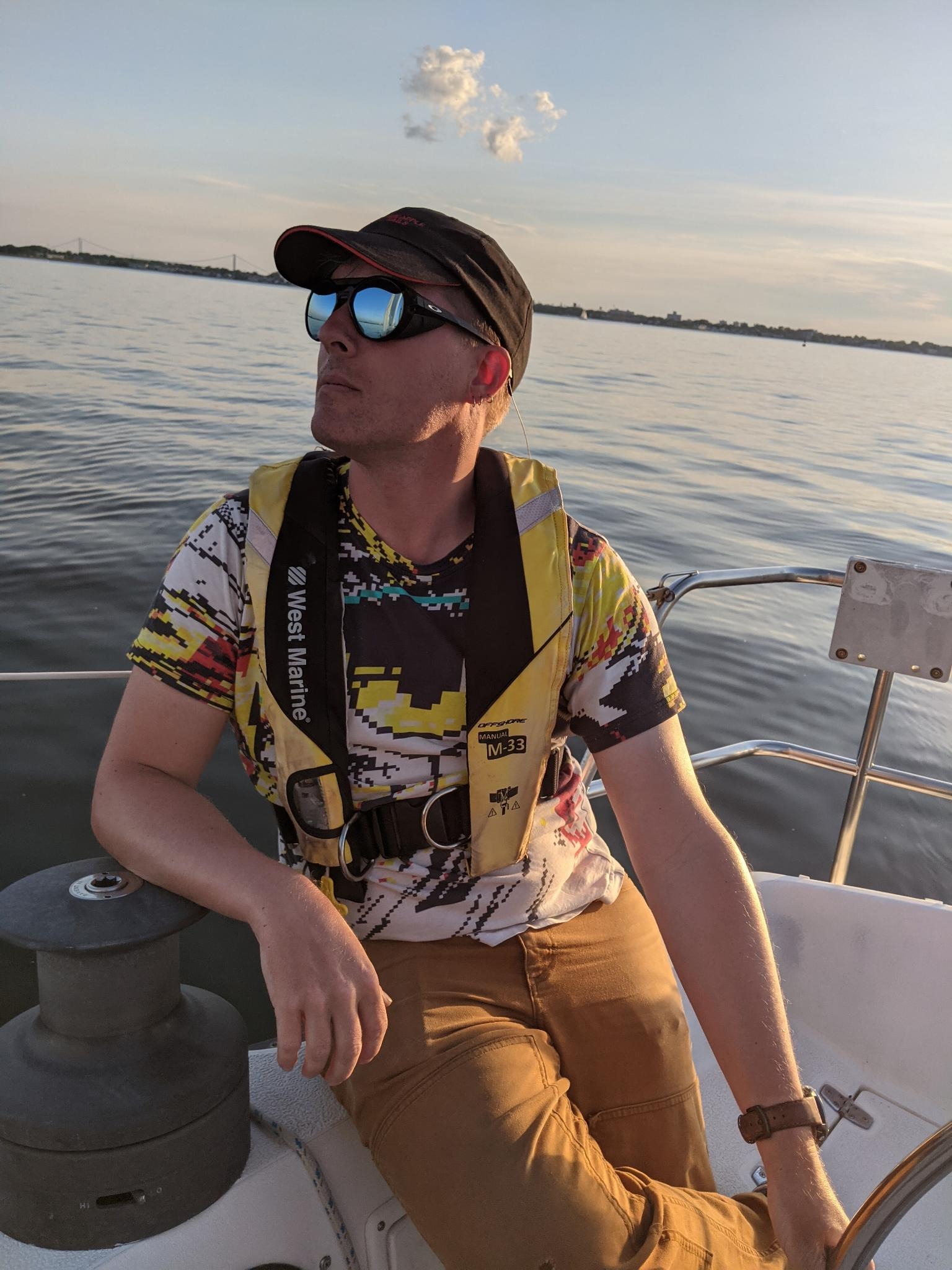 By
By 